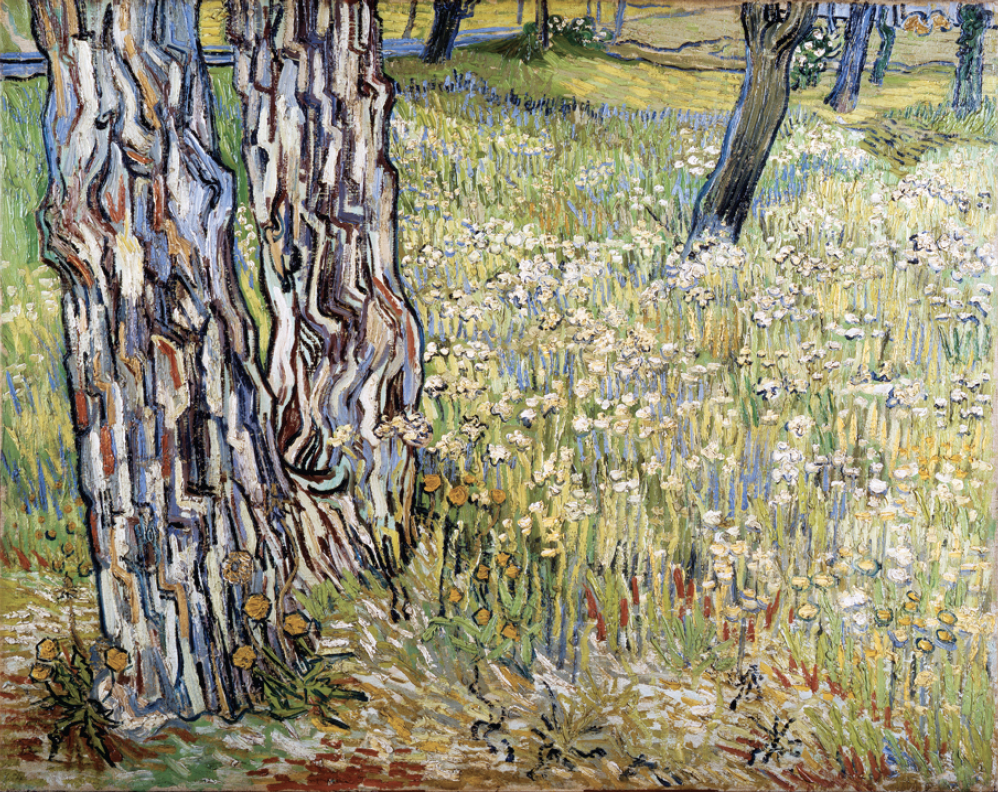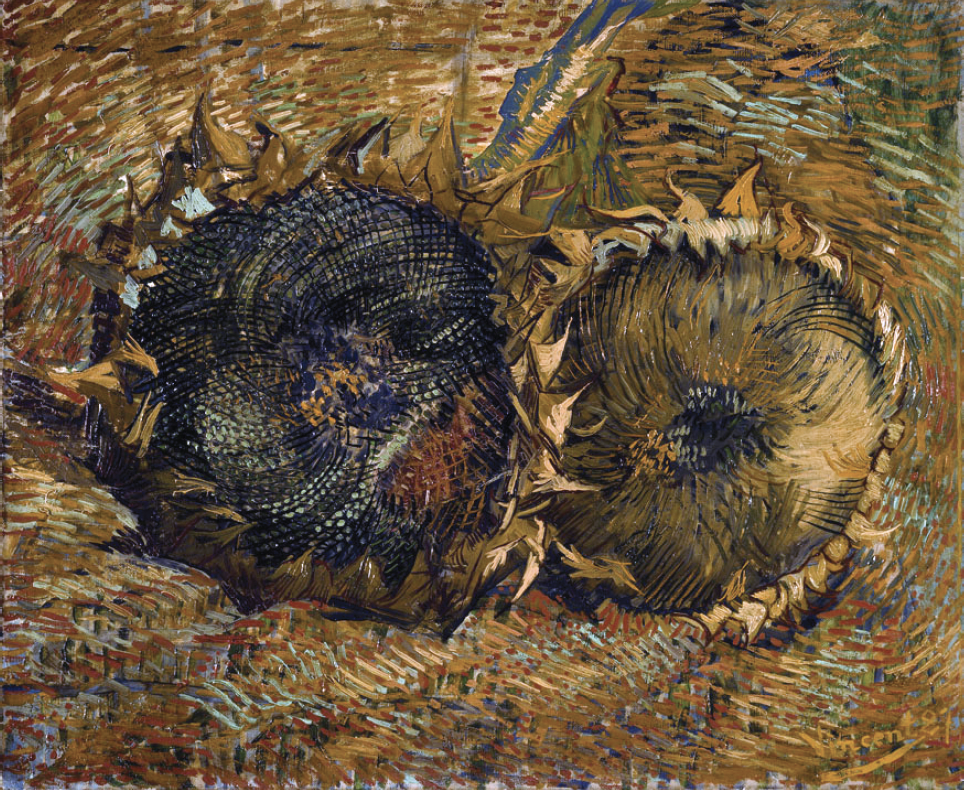Van Gogh
Given the fact that by eleven o’clock in the morning, an hour after the National Gallery’s opening, there was already a line of visitors one kilometre long stretching around the building, it is clear that the need to see paintings by Van Gogh is still an urgent, ravening one. This is all the more surprising when you consider that the paintings this press of people were so wildly eager to see were a modest collection (45 works) of modestly scaled Van Goghs, most of which were of modest subjects (flowers, grasses, moths, tree trunks)—lovely, intimately considered things (vignettes, visual haikus), but not the more corrosive, theatrical kinds of VG painting we all know to be surefire crowd-pleasers (Starry Skies, Sunflowers, “lonely rooms,” etc.).
The exhibition, “Van Gogh: Up Close” (VGUC), was jointly organized by the National Gallery and the Philadelphia Museum of Art, and curated principally by independent Van Gogh scholar Cornelia Homburg—whose concept it was—and by assistant curator Anabelle Kienle of the National Gallery, along with curatorial contributions by Joseph J Rishel and Jennifer A Thompson.
The exhibition focuses—an eminently suitable word in this context—on the years 1886–1890, stretching from Van Gogh’s two-year sojourn in Paris with his brother Theo, through his Gauguin-punctuated period in Arles, 1888–89—the year of the ear—through his asylum year in Saint-Rémy, 1889–90, to his final year, 1890, in the village of Auvers-sur-Oise, north of Paris, where he was frequently tended by Dr. Paul Gachet and where he shot himself on July 27th.

Vincent van Gogh, Tree Trunks in the Grass, 1890, oil on canvas, 72.5 x 91.5 cm. Coll. Kröller-Müller Museum, Otterlo. © Stichting Kröller-Müller Museum. Images courtesy the National Gallery of Canada, Ottawa.
The National’s mounting of VGUC entails arranging the exhibition as a series of six gradually intensifying, interrelated rooms, with titles ranging from those with a certain responsible banality, “Introduction,” through those aspiring to wit; room 2 is devoted to “Still Life: A New Angle,” while room 3 calls itself “Composing Nature.” Room 5, with the amiably workaday title “Structuring Landscape,” is flanked by very handsome offerings of “Japanese Prints” and “19th-century Photographs”—both exquisite collections resolutely ignored, as far as I could tell, by the Van Gogh-hungry crowd.
When I was there, the “Introduction” room was so packed you couldn’t breathe. For me, it was more of a Panic Room, mostly because viewers wearing audioguides (i.e., everyone) hadn’t yet been told to move on. Though it’s probably not a museologically constructive idea, “Van Gogh: Up Close” is nevertheless the kind of exhibition you really want to see all by yourself—so that it might be gently and slowly savoured, the way you want to pause and ponder over somebody’s well-thumbed journal or a bundle of illustrated letters tied with a ribbon. You want to be alone, for example, with a robust, tough-tender little painting like Undergrowth, 1889, a painting entirely full, from edge to edge, of green and shadowy, mussy, yellow brushstrokes from the Saint-Rémy asylum period, when the painter was trying to stay lucid and composed, and looking to small, bounded, high-focus moments in nature for comfort and release. How often, in his letters to Theo, does he mention the frequency with which he is “obliged to go and gaze at a blade of grass, a pine-tree branch, an ear of wheat, to calm myself”? How frequently does he take nourishment and stability from the ground beneath him?—the finest things in the exhibition, for me, are the artist’s sous-bois (undergrowth) paintings.
You want to be alone, as well, with paintings like Tree Trunks in the Grass, 1890—what an inexhaustible exploration of gnarled, writhing bark—and Ears of Wheat, 1890, a depthless, horizonless, all-at-once, allover, omnidirectional, pre-Pollock-like dance of looped and whorled wheat stems. And nobody would much enjoy being jostled past the two small Sunflowers paintings from 1887, one a bright suncatcher, the other, the one Gauguin wanted, a growling, stygian venture into the regretful beauty of ripeness and decline.

Sunflowers, 1887, oil on canvas, 50 x 60.7 cm. Kunstmuseum Bern.
There is a great deal to be learned in VGUC about Japonism in 19th-century European art generally—and especially the way it fuels much of Van Gogh’s work (the radical cropping, the elevated point of view, etc.). There are single blades of grass everywhere in the exhibition, and branches of cherry blossom and hithering-and-thithering butterflies and moths. Mention is made in the catalogue of the painter’s deep enjoyment of Pierre Loti’s Japan-based novel, Madame Chrysanthème, 1888, with its rapturous, up-close evocations of Japanese delicacy of observation: “Then there were butterflies,” writes Loti in his “With Gods Unknown” section, “huge butterflies and large queerly-shaped flies buzzing about the flowers; numbers of black moths fluttering sideways with fantastic jerks as if they could not steer with their heavy wings, which resembled black velvet…”
“Van Gogh: Up Close” is a pocket-exhibition. Here, instead of vista, there is presence; instead of troubled grandeur and turmoil, there is immediacy and an exhilarating sense of multum in parvo (“much in little”)—the Latin phrase meaning, as Carl Zigrosser notes in his beautiful little 1965 book of that title about miniaturization in art, that “a multiplicity of detail is concentrated into a unified principle, the particular is transformed into the universal, a largeness of meaning is conveyed with the utmost economy of means.”
Would anybody much care about the works in this delicate, detailed exhibition if Van Gogh were not already Van Gogh (the ear, the suicide, the astronomical prices)? Probably not. But there is exquisite painting here—much of which tiptoes quietly up to you and reorganizes your emotional ambitions. In fact, the entire exhibition makes you want to lie in the grass and resolve, once again, to pay far closer attention to everything around you in the natural world. ❚
“Van Gogh: Up Close” was exhibited at the National Gallery of Canada, Ottawa, from May 25 to September 3, 2012.
Gary Michael Dault is a critic, poet and painter who lives near Toronto.

